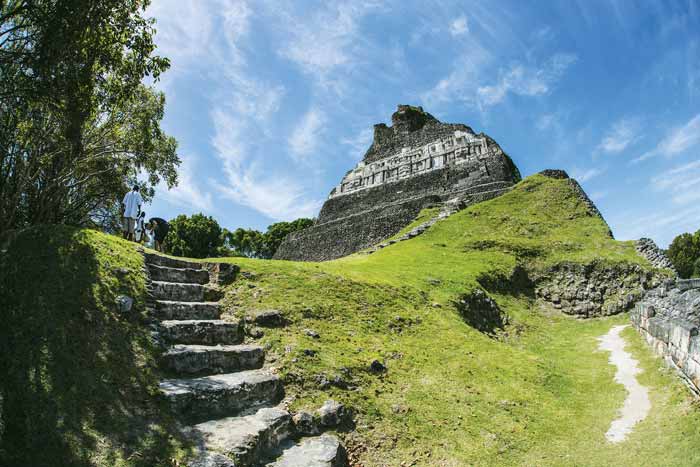Excellent article about Xunantunich from Taste of Life magazine.
Exploring The Mystery Of The Maya
Within the rainforests of Western Belize, the legacy of ancient Maya lives on as archaeologists unearth sacred temples and artistic traditions that provide a window into the mystery of a culture that excelled in agriculture, mathematics, hieroglyphics and impressive architecture.

Mayan for "Stone Maiden," Xunantunich, was an important royal ceremonial centre built around 600 AD. Its plazas once painted in vivid colours are surrounded by temples and palaces - the largest being, El Castillo.
A symphony of howler monkeys, parakeets and toucans announce a new day at the foothills of the ancient mountains of Belize. An alarm clock is a trivial possession here in the Cayo District, where creatures great and small sing homage to Kinich Ahau, the Mayan sun god, as the first golden rays slice through the dense jungle.
Through morning mist, there's a glimpse of El Castillo, the castle-like pyramid atop a distant limestone ridge. The mystery of the ancient Mayan site, Xunantunich (pronounced shoo-nahn-too-nitch), which surrounds the pyramid, enticed us to trek here, where the Mayan Empire was at the height of its power 2,000 years ago.

In the period between 300 and 900 A.D., the Maya built hundreds of enormous cities and sacred sites deep in the tropical lowlands of Belize, in northern Central America. While speculation exists, no one knows for sure what caused the Maya to mysteriously abandon their colossal temples, leaving them to be swallowed up by the encroaching jungle until they became the lost cities of legend.
The ancient ceremonial centre Xunantunich was discovered by a hunter in 1881, and as excavation continues today, altars, artefacts and stone friezes are being unearthed alongside a fragmented story of humanity's past.
"For every relic unearthed, there's a thousand questions, and for every question answered there's a hundred more questions," says William, our tour guide - a local rancher and horse handler who grew up exploring the ancient caves around the nearby village of San Jose Succotz. "So much mystery shrouds the Maya. How could they build pyramids without iron tools, wheels or animal power?"

The road leading to this ancient site weaves along the Mopan River, through a jungle canopy of fragrant allspice and gumbo-limbo trees. While the idea of riding horseback through the rainforest gets some pushback from our teenage sons, as we cross the river on a small platform propelled by a hand-cranked pulley, their hesitation transforms to wonder as we enter Mayan territory.
Far richer, fascinating and more exciting than anything Hollywood could dream up, the actual reality of Mayan life is amazing. This was once the capital of an autonomous ancient kingdom - spreading out with 26 stone structures and multiple plazas, many yet to be uncovered. Nearly 200,000 Maya once lived beneath the shadows of the pyramid, with its giant stone steps ascending to a summit 40 metres above the jungle floor.
Its assembly of stone rooms and vaulted buildings suggests it was once a royal palace or residence of an elite family closely related to the rulers. Like an emperor surveying his kingdom, the view is astounding - stretching across the horizon from the lush forest greens and farms around San Ignacio to Guatemala.

It's remarkable to think that where we now stand once served as a sacred space to honour the gods - echoed by the intricate stone friezes and masks that adorn the east and west of the pyramid. Various motifs and symbols of Mayan astronomy and cosmology are etched in limestone, including Chaac, the god of rain, and Ix Chel, the moon goddess.
This ancient royal retreat is complete with a ball court, although from hieroglyphics discovered on neighboring Mayan sites, the game known as pok-ta-pok took an intense twist with the sacrificial death of the winner - the perfect gift to win favour from the gods. Next to the excavated sports court is a lonely sapodilla tree - its chicle sap used to make rubber balls for this game, and in generations to follow, dental floss and chewing gum.

This real, in-your-face Mayan history has ignited our curiosity! Perhaps we'll continue onto Altun Ha, north of Belize City, where an exquisite piece of ancient Mayan art, the Jade Head, was discovered in a large tomb, or onto Ambergris Caye and the 2,000-year-old Marco Gonzalez archaeology site in the early days of discovery.
As we ride back to the stables, our minds are opened to life's deeper meaning. A legacy seems more than what's left when we're gone, but what we can each give, create, impact and contribute today while we're here. Taking the rough road often leads to the height of greatness.
Taste of Life

